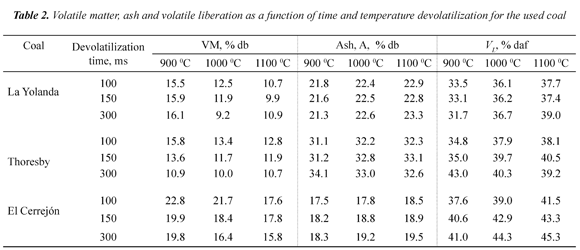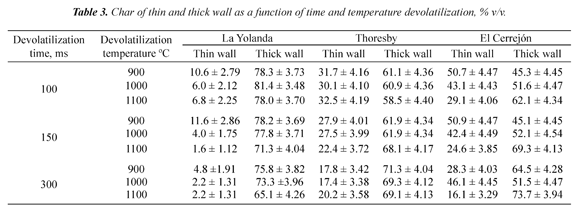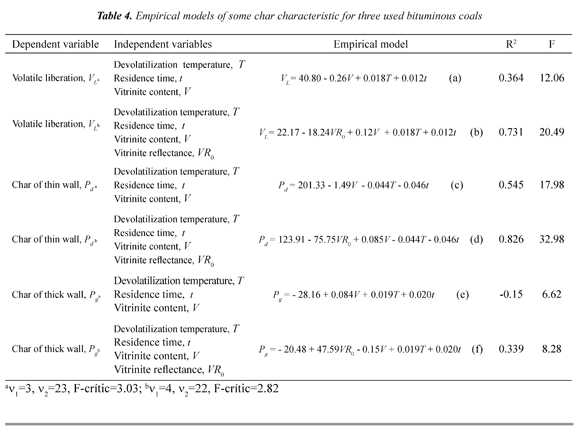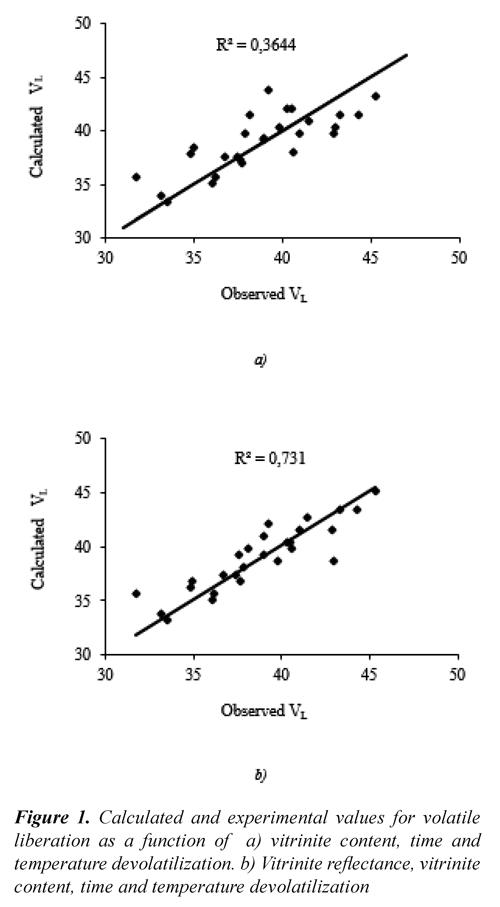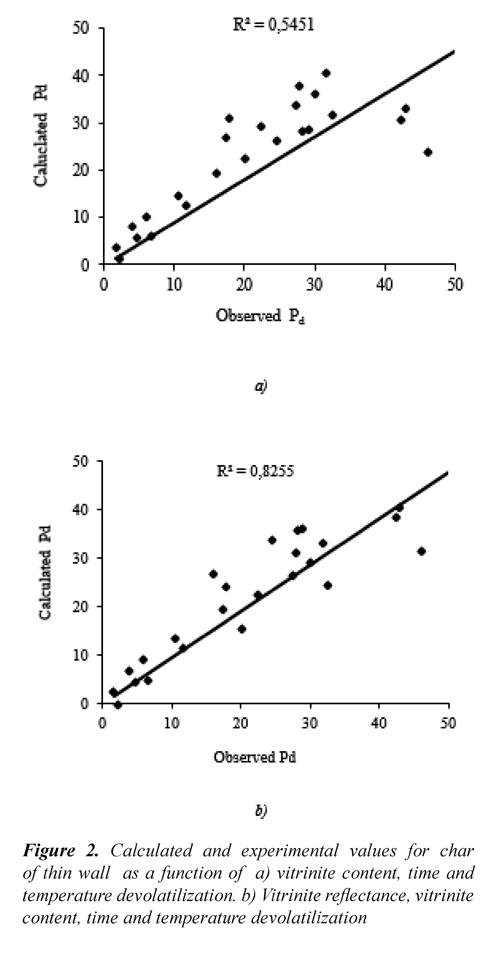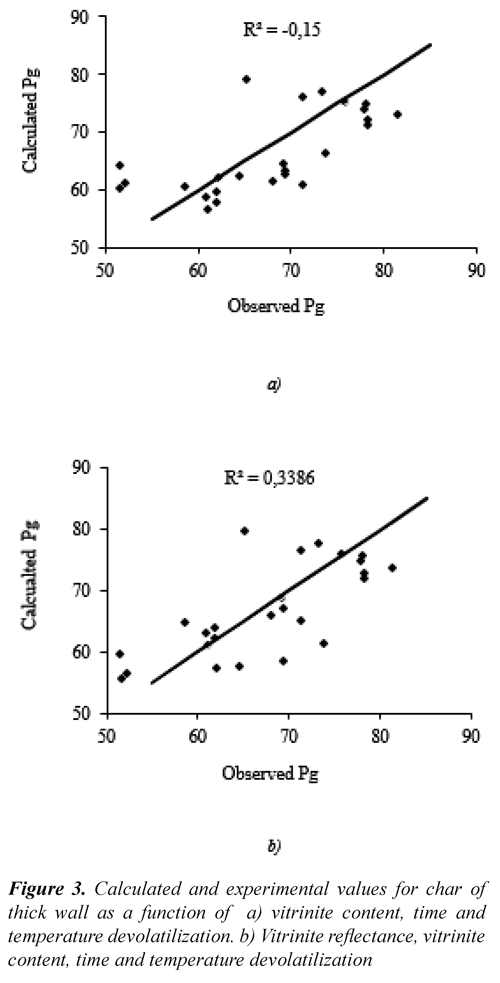Serviços Personalizados
Journal
Artigo
Indicadores
-
 Citado por SciELO
Citado por SciELO -
 Acessos
Acessos
Links relacionados
-
 Citado por Google
Citado por Google -
 Similares em
SciELO
Similares em
SciELO -
 Similares em Google
Similares em Google
Compartilhar
Ingeniería y competitividad
versão impressa ISSN 0123-3033
Ing. compet. vol.15 no.2 Cali jul./dez. 2013
Volatile matter release and thin and thick char formation as a function of vitrinite content, coal rank, time and temperature devolatilization
Liberación de materia volátil y formación de carbonizados de pared gruesa y delgada en función del contenido de vitrinita, rango del carbón, tiempo y temperatura de desvolatilización
Andrés Felipe Rojas-González
Departamento de Ingeniería Química, Facultad de Ingeniería y Arquitectura, Universidad Nacional de Colombia Sede Manizales, Manizales, Colombia
E-mail: anfrojasgo@unal.edu.co
Juan Barraza
Escuela de Ingeniería Química, Facultad de Ingeniería, Universidad del Valle, Cali, Colombia
E-mail: juan.barraza@correounivalle.edu.co
Eje temático: Chemical engineering / Ingeniería química
Recibido: 22 de abril de 2013
Aceptado: 17 de Agosto de 2013
Abstract
Pulverized coal combustion is determined by char chemical reactivity, which depends of its morphology developed during the devolatilization process. In this work, some empirical relationships were obtained, in order to determine the composition of thin and thick walled char, as well as volatiles liberation, as a function of process variables (temperature and time devolatilization) and coal properties (vitrinite content and vitrinite reflectance). Those empirical models can be used to improve the combustion modelling and to simulate the char chemical reactivity. It was found that the empirical models, to predict different char morphology, gave a good approximation from coal properties and characteristic parameters of the devolatilization process, involving coal rank.
Keywords: Thin-walled char, thick-walled char, volatiles liberation, empirical models.
Resumen
La combustión de carbón pulverizado está determinada por la reactividad química del carbonizado, siendo esta reactividad dependiente del tipo de morfología desarrollada durante el proceso de desvolatilización. En este trabajo se obtienen algunos modelos empíricos, para determinar la composición de los grupos morfológicos de pared delgada y de pared gruesa al igual que la liberación de volátiles, en función de variables del proceso de desvolatilización (temperatura y tiempo) y propiedades del carbón (contenido de vitrinita y reflectancia de la vitrinita) que dan origen al carbonizado. Estos modelos empíricos se pueden usar en modelos de combustión para mejorar la modelación del proceso de combustión y la simulación de la reactividad química del carbonizado. Se encontró que los modelos empíricos para la predicción de las diferentes morfologías del carbonizado produjeron una buena aproximación a partir de propiedades del carbón y de parámetros característicos del proceso de desvolatilización, involucrando el rango del carbón.
Palabras clave: Carbonizados de pared delgada, carbonizados de pared gruesa, liberación de volátiles, modelos empíricos.
1. Introduction
During the pulverized combustion, coal particles are first pyrolyzed and after that burned. The pyrolysis product is a solid having low volatile matter and high fixed carbon content, which is called char. After char formation, the solid residue is burned at a burning rate affecting the combustion equipment design. The burning rate is function of char type; and its morphology depends on pyrolysis conditions and characteristic of the coal precursor. Then, it is particularly interesting to predict the char morphological content from devolatilization conditions and coal properties.
The formed char depends on maceral content, coal rank, particle size, char formation temperature, minerals presence [Cloke, 1994], microlitotypes and litotypes content [Bailey, 1990], heating rate during devolatilization, gas room [Chan, 1999] and residence time [Jones, 1999]. It has been reported that liptinite does not contribute significantly to char formation, but contributes to liberation volatile rate [Cloke, 1994; Valentim, 2004] and to the flame stability [Shibaoka, 1969], while the vitrinite and inertinite are considered precursors of the formed char type [Shibaoka, 1985]. It has seen that coal having high concentration of vitrinite produces morphology like cenospheres [Thomas, 1989]. Cloke, 1994 reported that the type of formed char from vitrinite is influenced by both coal rank and thermoplastic behavior of vitrinite particles during pyrolysis. They found that high coals rank produced network of thick wall (crassinetwork) and cenospheres, while the low coals rank rich in vitrinite generated a variety of char type network of thin wall char (tenuisphere). Meanwhile, the inertinite maceral can produce almost all types of chars, from thin wall cenospheres and pore networks to solid dense [Cloke, 1994], but in general, inertinite produces char having low porosity such as thick-walled network and solids [Valentim, 2004]. Usually, inertinites from low rank coal are swelled and form thick-walled network chars and a mixture of porous wall and solid, while inertinite from high coal rank produce solid and fusinoid. It has been found [Menendez, 1995] that coals with high inertinite content produces char with lower porosity in comparison to those with low content inertinite.
On the other hand, the devolatilization temperature affects the formation of different char morphology from coals concentrated in vitrinite. Chars of thin-walled having high porosity were obtained at low devolatilization temperature [Cloke, 1994], whereas thick-walled such as thick-walled cenospheres, pore networks and mixtures were obtained at high devolatilization temperature [Rosenberg, 1996; Petersen, 1998].
Devolatilization time has also effects on the char morphology. Tenuisphere, crassisphere, crassinetwork and tenuinetwork decrease with increasing devolatilization time, while inertoid and fragments increase with time of devolatilization. Regarding morphological groups, char of thinwalled, and thick-walled decrease with increasing devolatilization time [Rojas et al., 2008].
The aim of this study was to determine, through empirical models, the composition of char morphological groups of thin wall (tenuisphere+tenuinetwork) and thick wall (crassisphere+ crassinetwork), as well as volatile liberation, as a function of devolatilization variables (temperature and time) and coal properties (content of vitrinite and vitrinite reflectance).
2. Experimental
Parent coal characterization. Two Colombian coals (La Yolanda and El Cerrejón) and one UK coal (Thoresby) were used in this study. All these coals were ground to pulverized fines specification (75% under 75 microns). The proximate analysis was carried out in a thermogravimetric analyzer LECO TGA 601. Maceral contents for coal samples were obtained by manual analysis using an optical microscope (Leitz Ortholux II POLBK) with a 32 X magnification oil-immersion lens. Random Vitrinite reflectance was measured using a photometer and 100 separate measurements, each being taken from a homogenous area of vitrinite on individual particles.
Char preparation. The -75 micron coal fractions were fed to a tubular entrainment reactor operating at three temperatures (900, 1000 and 1100ºC) under a N2 environment, three residence times (100, 150 and 300 ms) with a heating rate of 104 K/s. A diagram of the devolatilization system and equipment specification is presented by Rojas [Rojas, 2005].
Char characterization. The proximate analysis of chars was also carried out in the thermogravimetric analyzer LECO TGA 601. Morphology characterization of the char samples was carried out using image analysis system with Kontron KS400 automated image analysis software [Lester et al., 2003a,b]. It identified 1000 char particles and characterized them with regard to their external area, Feret's minimal and maximum diameter, pores number, wall thickness percentage lesser than 3 and 5 µm, wall thickness average, porosity and sphericity. The program classified every char morphology according to tenuisphere, crassisphere, tenuinetwork, crassinetwork, mixed porous, mixed dense, fusinoid, solid and mineroid. With this analysis, it was established the proportion of thin-walled char as the addition of tenuisphere and tenuinetwork, whereas the proportion of thick-walled char was the accumulation of tenuinetwork and crassinetwork. Images of char characteristics have been reported by Rojas, 2005 [Rojas, 2005].
Volatile liberation. It was employed an indirect method to evaluate the volatile liberation percentage using the ash of precursor coal and char as a tracer [Badzioch&Hawksley, 1970; Barranco et al., 2000, 2003]. The volatile liberation ( VL ) was determined by the equation 1:

Where Achar and Acoal represent the ash of char and coal percentages respectively.
Empirical models. The empirical models were obtained using an ANOVA analysis with a Design-Expert 6.0 software. Linear regressions evaluated the char of thin wall, char of thick wall, and volatile liberation as a function of process variables (temperature and time devolatilization) and coal characteristics (vitrinite content and vitrinite reflectance). Those independent variables were used because they mainly affect the coal combustion process [Wuet al., 2003; Barranco, 2001]. The form of the linear regression with some parameters is given by:

Where Y represents both volatile liberation and wall char characteristic; X1, X2,., Xn, temperatura and time devolatilization, vitrinite and coal rank; and a0, a1, a2, .... , anregression constants. In order to evaluate the variance and significance of results, it was estimated the F distribution and the multiple determination coefficient R2 [Montgomery & Runger, 1999].
3. Results and discussion
Coal and char characterization. The characteristics of the three coal samples are shown in Table 1. According to the vitrinite random reflectance, La Yolanda coal is the highest rank, while El Cerrejón coal is the lowest rank. La Yolanda coal has both the highest fixed carbon and vitrinite content, Thoresby coal has the highest ash and liptinite content and El Cerrejón coal presents the lowest ash and major inertinite content (semi-fusinite + fusinite).
Table 2 shows the volatile matter (dry basis, db), ash content (db) and volatile liberation percentage (db) of chars obtained at the devolatilization temperatures and time used in this work. The table 2 shows that in general the chars presented lower volatile matter in comparison to the precursor coals, which indicates that the coal samples were not completely devolatilized. Those volatile remains in the chars play a significant role in coal combustion, especially when the ignition of the remaining volatile matter of chars takes place, helping flame stability [Vargas et. al, 2013]. As it is seen, the volatile content of the La Yolanda coal decreased from 28.8% to 9.2%, Thoresby coal from 26.7% to 10.0, while Cerrejón coal from 35.6% to 15.8% db. It was observed that in general for all the chars, there was an increase of the ash concentration. In general, the volatile liberation was higher than 31%.
Morphological characterization of char groups is showed in Table 3. In general, for all coals there is abundance of thick wall chars, presenting Yolanda coal the highest proportion. Those findings suggest that La Yolanda chars are less reactive than the other chars, which agrees with its high rank. Chars from Cerrejón coal presented the lowest composition of thick wall and the highest proportion of thin wall, which indicates that they can be the most reactive. It should be noted that Cerrejón coal is the lowest rank of the three coals. Chars from Thoresby coal showed that its morphological groups were between the obtained for La Yolanda and Cerrejón coals, suggesting that those chars have intermediate reactivity. Concerning the effect of devolatilization time at constant temperature on the char morphological groups, it is seen that in general for the three coals, chars of thin and thick wall decreased with increasing devolatilization time.
Obtaining empirical models. Empirical models were obtained to determine the percentage of volatile liberation and chars of thin and thick wall in terms of two sets of independent variables. The first one consists of vitrinite content, time and temperature of devolatilization, while the second one included the three above plus the coal rank given by random vitrinite reflectance. Table 4 presents the independent variables set, the empirical models, the multiple coefficient determination and the F factor for each observed variable.
Table 4 shows that for the first model (equation a), both time and temperature devolatilization favor the volatile liberation percentage. However, the presence of vitrinite content decreased volatile liberation. The second relation (equation b) shows a similar behavior for temperature and time devolatilization, but the presence of vitrinite content and vitrinite reflectance have a negative influence on the liberation of volatile. The vitrinite reflectance parameter (coal rank) corrected the effect of the vitrinite content, indicating that volatile liberation decrease with coal rank. This result agrees with the structure of the coal because of high rank coals have low volatile content, therefore the volatile liberation is low during the devolatilization process. The above results are important to improve an actual pyrolysis process, which aims to release the volatile matter of the coals, using high residence times, high temperatures and medium rank coals.
Regarding to results of thin-walled char (equation c), it is shown that the time, temperature devolatilization and vitrinite content affect negatively the production of char of thin wall, suggesting that the generation of thin-walled particles during devolatilization is favored at both low time and devolatilization temperatures. It can be due to those conditions, coal does not reach to reorganize its structure. This kind of morphology is usually produced in coal of low rank and it is in agreement with the obtained results. [Barranco, 2001; Wu et al., 2003].
Concerning the char of thick wall, equations (e) and (f) show that there is an agreement with experimental results, since the thick-walled structures are favored by increasing the temperature devolatilization, time devolatilization and coal rank. The above results can be related to an actual process of combustion in order to produce thinwall chars, which are ideal by its high reactivity. Thin-wall chars were analyzed by TGA, which showed to have low activation energy [Rojas et al., 2005]. Chars of thin wall can be obtained at short residence times and low temperatures in the zone where devolatilization occurs. On the other hand, it would be not convenient to use both high residence times and temperatures in combustion processes due to it produces thick-walled chars, which are not very reactive and could generate unburned as part of bottom or fly ash.
In general, table 4 shows a poor model between vitrinite content, temperature and time devolatilization with volatile liberation and chars of thin and thick wall. This is caused by the low determination coefficient R2 and F factor. However, those models are improved when vitrinite reflectance is involved.
The empirical models of volatile liberation and char of thin and thick wall were correlated with the experimental results for the two sets of independent variables, such as it is shown in figures 1 to 3. Figure 1 shows a vast data dispersion, noted by the low determination coefficient R2 (0.364). However, when the vitrinite reflectance is included at the statistical analysis (figure 1a), there is an improvement of the determination correlation (R2 = 0.731), confirming that coal rank has a good effect on the volatile liberation.
For the chars of thin wall, it is seen in figure 2 that the determination coefficient increased from 0.54 to 0.82 when coal rank is included in the model. Those results indicate that the coal rank is an important parameter to produce char of thin wall. In figure 3, it is also showed that for the char of thick wall, coal rank plays also an important role in that kind of morphology. However to improve this correlation, another parameter would be used such as inertinite content, moisture or volatile matter from precursor coal [Wu et al., 2003].
4. Conclusions
Coal of high rank favors the production of thick-walled chars during the devolatilization process. Chars of thin wall are produced at low devolatilization temperature and short devolatilization time, chars of thick wall are generated at intermediate times and temperatures, and finally char solid type are produced at high temperatures and long times devolatilization. It was found that that besides the vitrinite content, temperature and time of devolatilization, the coal range is an important parameter both in the volatiles liberation and in the development of type char.
5. Acknowledgements
A. Rojas thanks to Universidad del Valle, Cali- Colombia, for the opportunity to develop his Ph.D. thesis in the Chemical Engineering area, entitled "Kinetic study of the char combustion from pulverized coal".
6. References
Badzioch, S. & Hawksley, M., (1970). Kinetics of thermal decomposition of pulverized coal particles. Ind. Eng. Chem. Process Des. Develop. , 9 (4), 521-530. [ Links ]
Bailey, J.G., Tate, A., Diessel, C.F.K. & Wall, T.F., (1990). A char morphology system with applications to coal combustion. Fuel , 69, 225-239. [ Links ]
Barranco, R., (2001). The characterisation and combustion of South American coals . Doctor of Philosophy Thesis. University of Nottingham. Nottingham, UK. [ Links ]
Barranco, R., Cloke, M. & Lester, E. (2003). Predicción del comportamiento a la combustión de algunos carbones suramericanos en un reactor tubular vertical. En, Congreso Colombiano del Carbón. Medellín, Colombia. [ Links ]
Barranco, R., Cloke, M., & Lester, E (2000). The effect of operating conditions and coal type on char reactivity and morphology during combustion in a drop tube furnace. International Conferences of Coal . Recovered 2015/01/20 http://aie.org.au/AIE/Documents/CD_Contents_Conference_Proceedings/ACSC_2000/comb-bar.pdf [ Links ]
Chan, M.L., Jones, J.M., Pourkashanian, M. & Williams, A., (1999). The oxidative reactivity of coal chars in relation to their structure. Fuel , 78, 1539-1552. [ Links ]
Cloke, M. & Lester, E., (1994). Characterization of coals for combustion using petrographic analysis: a review. Fuel , 73 (3), 315-320. [ Links ]
Jones, J.M., Pourkashanian, M., Rena, C.D. & Williams, A., (1999). Modelling the relationship of coal structure to char porosity. Fuel , 78, 1737-1744. [ Links ]
Lester, E., Watts, D. & Cloke, M. (2003a). Burnout prediction using advance image analysis coal characterization techniques. 12th Int. Conference on Coal Science (6C2). [ Links ]
Lester, E., Watts, D. & Cloke, M. (2003b). Automated maceral and microlithotype analysis on particulate coals. 12th Int. Conference on Coal Science , (7C4). [ Links ]
Menéndez, R., Borrego, A.G., Bailey, J., Fuente, E. & Álvarez D., (1995). The effect of inertinite content on coal combustion reactivity. Coal Science and Technology , 24 (1), 303-306. [ Links ]
Montgomery, D. & Runger, G., (1997). Design and analysis of experiments (4 ed.). New York, USA: John Wiley & Sons. [ Links ]
Montgomery, D. & Runger, G., (1999). Probabilidad y estadística aplicadas a la ingeniería . México D.F.: McGraw-Hill. [ Links ]
Petersen, H., (1998). Morphology, formation and palaeo-environmental implications of naturally formed char particles in coals and carbonaceous mudstones. Fuel , 77 (11), 1177-1183. [ Links ]
Rojas, A.F. & Barraza, J.M., (2008). Caracterización morfológica del carbonizado de carbones pulverizados: determinación experimental. Revista Facultad de Ingeniería Universidad de Antioquia , 43, 42-58. [ Links ]
Rojas, A.F., (2005). Estudio cinético de la combustión del char de carbón pulverizado . Tesis doctoral. Doctorado en Ingeniería. Universidad del Valle. Cali, Colombia. [ Links ]
Rosenberg, P., Petersen, H. & Thomsen, E., (1996). Combustion char morphology related to combustion temperature and coal petrography. Fuel , 75 (9), 1071-1082. [ Links ]
Shibaoka, M., (1969). Combustion of coal in thin sections. Fuel , 48, 285-295. [ Links ]
Shibaoka, M., Thomas, C.G. & Young, B.C. (1985). The influence of rank and maceral composition on combustion of pulverized coal. In, Proceedings of the 1985 International Conference on Coal Science, NEDO (pp. 665-668). [ Links ]
Thomas, C.G., Shibaoka, M., Gawronski, E., Gosnell, M.E., Ponganant, D., Brunckhorst, L.F. & Salehi, M.R. (1989). Swelling and plasticity of inertinite in pf combustion. In, Proceedings of the 1989 International Conference on Coal Science, NEDO (pp. 213-216). Tokyo. [ Links ]
Valentim, B., Lemos de Sousa, M.J., Abelha, P., Boavida, D. & Gulyurlu, I. (2004). Relation between the petrographic composition of coal and the morphology of pyrolysis char produced in fluidised bed. Energy & Fuels , 18, 611-618. [ Links ]
Vargas, D., Chaves, D., Trujillo, M., Piñeres, J., Barraza, J., (2013). Char morphology of beneficiated coals. Ingeniería e Investigación , 33 (1), 13-17. [ Links ]
Wu, T., Cloke, M., Barranco, R. & Lester, E., (2003).The relationship between char morphology and its parental coal properties. 12thInt. Conference on Coal Science , (2C4). [ Links ]

Revista Ingeniería y Competitividad por Universidad del Valle se encuentra bajo una licencia Creative Commons Reconocimiento - Debe reconocer adecuadamente la autoría, proporcionar un enlace a la licencia e indicar si se han realizado cambios. Puede hacerlo de cualquier manera razonable, pero no de una manera que sugiera que tiene el apoyo del licenciador o lo recibe por el uso que hace.














